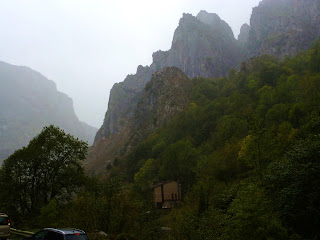We had planned a day of sightseeing around the Cudillero area, but as we had breakfast in a local café -toast and a paste of fresh tomato and garlic spread (see above) with cafe con leche… E5.80 for the two of us) the weather forecast showed thunderstorms for Picos for the next day, so we decided to get to the mountains a day earlier.
TomTom reprogrammed and we were away, mainly motorway travel, no tolls, lots of viaducts over valleys (the Romans really started something, and the locals still think they are a great idea). We had the odd “Take the exit” instruction that could not be executed due to construction work, but the ever flexible TomTom took us on to the next exit, and then immediately back in the direction from whence we came where the off ramp was still operational so on we went, gathering confidence in her….no Port yet though.
Arrived in Cangas de Onis, crowded with locals on a national holiday weekend. Took a photo of the 13th Century bridge with the Asturian cross symbol.
A sustaining coffee and croissant/Danish and then off to Covadonga. This is the place where Spain has always been Spain…it was never occupied land. This valley was where the Moors were stopped in their advance up the Iberian Peninsula. The Caliph of Cordoba ordered the Moors to attack and clean the place out of Christians, however they were easily defeated in the very steep valley, giving the Christians the belief they could defeat them and they moved south and pushed Muslims back to Africa, this process took a mere 800 more years. (Note: must check the El Cid story from Charlton Heston movie days when I get home.)
We parked the car and were driven the 12 km up to Lagos by bus. The road…very narrow, unsure how the buses actually managed to squeeze past in places. Plenty of very white knuckles and relieved people got out at the top.
We had intended a 2.5 hour walk, but by the time we arrived at Lagos it was around 3 00pm and we still had to get off the mountain and drive to Llanes, so we took the 1 hour short route.
The Picos are 65 000 hectares and are three lumps of limestone upthrust at a tectonic plate joint where the high sea cliffs from the other day which are granite form the other side. They now form a national park, but the traditional farming (cows, sheep and goats) carries on.
This has no adverse impact, and the absolute clarity of the rapidly flowing water in the streams would support that.
We have tried the local chorizos with Queso Cabrales (a tasty blue made from a mix of goat sheep and cows milk and the milk is unpasteurised) I can see David Munro shaking his wise head!! Washed down with a local red 80% Temperanillo and 20% Cab Sav 2002 Riserva… very nice, thank you very much. LLanes is very pretty harbour village. Like Cudillero without the steep hills around it.
Today we drove back up to Poncebos where there is another valley entrance to the interior of the Picos. Fascinating country and a lovely drive. The high steep peaks, shrouded in rain clouds, made for great atmosphere.
Visited the Quesa Cabrales Museo so now understand a little more of its origin and manufacture. (Three different milks – cow, sheep and goat.) It's a very manual process, protected by regulation (this is Europe keeping its tradition). What do you do with the whey? (traditionally it is fed back to the stock, couldn’t determine what happens in the current process.)
Heavy showers, so no walking and crowds absent as the locals must have returned home. Coffee and a snack at a local and then home to Llanes. Popped in to the local deli equivalent, which sells artesano products, some English spoken which is handy, and walked out with a huge slab of chocolate with almonds (tucker for the boat, and restocking the larder which was raided for a late night Port at one point you may recall. Also got a bottle of the local (Asturian) speciality cider which helped fill one of the between-food gaps today. When you don’t eat till around 9 00 pm you need to take the local approach to eating ie breakfast, lunch, snack, dinner.
Tonight we will dine out at a local recommended by the deli lady, and will try the local dish – Fabado. This is a white bean stew combined with a selection of meats, usually four: chorizo, morcilla, ham and bacon. Unsure what you wash it down with but it won’t be the cider which is now in the “been there, done that” pile.
But having now had the famed Fabado Austurianos it definitely has a place in the ongoing diet. We were the only non-Spanish at the restaurant and the E10 menu de noches per head covered wine (1 litre) water, de entradas, segundos, postres, cafe…. Very full!











No comments:
Post a Comment